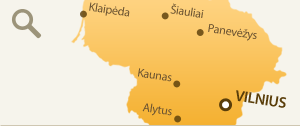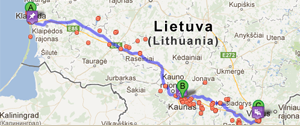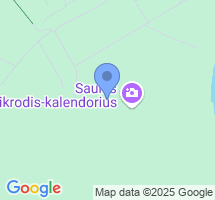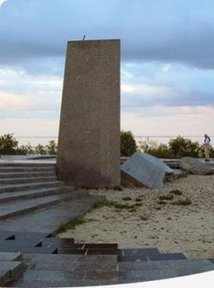Solar Clock-Calendar (Nida)
In 1999 the Sundial was broken by hurricane Anatoly therefore the following description might differ from its present state.
A project of the Sundial was made by an architect Ricardas Kristapavicius. A professor Libertas Klimka assisted as a specialist in the fields of old astronomy. A sculptor Klaudijus Pudymas was responsible for creating an artistic part of the project. The Sundial was built in March 11, 1995. From the astronomical point of view the Parnidis dune is an ideal and unique place for this Sundial where opens an absolute mathematical horizon. Only there you will see the sunrise from the lagoon and the sunset to the Baltic Sea.
A shadow as a clockwise makes its daily circle, falls from the obelisk built in the centre of a platform. The obelisk stone weighing 36 tone was brought from the quarry of Karelia. This obelisk is pretty strong architectural element. The Parnidis dune erects it to 53 meters height as to the highest point of the spit. However, looking from the Urbo hill, Nida or the sailboat deck, this obelisk of the Sundial is barely visible as if a hint or a sign of something. The Sundial allure is observed coming close to the foot of the Parnidis dune and only from there one can realize that this is an erection. Climbing up, the obelisk is getting bigger as long as it overtops human’s scale and becomes a cosmic connection between heaven and earth.
Hours and half hours carved in a semi circle on the small stages are covered with granite slab. One for each month and other four for solstice and equinox. In every stage the semi circles are getting higher towards equinox and decreasing towards solstice. The largest semi-circle belongs to June, two small ones to December and January. The granite is engraved with celestial luminaries and graphics of eternal route. Each line of a scale is dictated by the rhythms of nature: nothing unnecessary, no creative notions. The geometry of mini stages reminds us the sand layers winded from olden dunes. The flowing time on the Parnidis dune could be felt physically. We see how the shadow of the obelisk is inexorably moving along the scale, and every sunrise and sunset, moreover, the noon is a great cosmic event on this platform. On special calendar days, namely in solstice and equinox, like the ancient priests and priestesses we can set the astronomic beginning of a season.
Furthermore, this Sundial shows local time. Every time the shadow recalls to a holidaymaker, that a man is nature’s child, dependent on its rhythms. Only nature is free to give strength and recovery.
Source: www.baltai.lt
Nearby objects
 Nuomojame nuo balandžio15d. iki spalio 15d, kaina asmeniui 30-40 Lt. (~51.9 km)
Nuomojame nuo balandžio15d. iki spalio 15d, kaina asmeniui 30-40 Lt. (~51.9 km) Horsemarket jojimo paslaugų centras – puiki vieta mėgstantiems žirgus, gamtą ir geras emocijas. (~58.9 km)
Horsemarket jojimo paslaugų centras – puiki vieta mėgstantiems žirgus, gamtą ir geras emocijas. (~58.9 km) Vieno kambario apartamentų nuoma Palangoje vos už 50 Lt. parai (~69.6 km)
Vieno kambario apartamentų nuoma Palangoje vos už 50 Lt. parai (~69.6 km) Viešbutis, restoranas, mini SPA, vyno rūsys, konferencijų salė. (~149 km)
Viešbutis, restoranas, mini SPA, vyno rūsys, konferencijų salė. (~149 km) Šiaurės Lietuvoje, 28 km nuo Šiaulių, 5 km nuo Radviliškio, 49 km nuo Panevėžio, pakeliui į Tytuvėnus ir Raseinius, miškų apsuptyje, kur… (~169.8 km)
Šiaurės Lietuvoje, 28 km nuo Šiaulių, 5 km nuo Radviliškio, 49 km nuo Panevėžio, pakeliui į Tytuvėnus ir Raseinius, miškų apsuptyje, kur… (~169.8 km) Niekada negali žinoti ar tau patiks, kol pats neišbandai naujos pramogos. (~188.9 km)
Niekada negali žinoti ar tau patiks, kol pats neišbandai naujos pramogos. (~188.9 km) Viešbutis „Metropolis“, garsėjantis įspūdinga istorija, yra vienas iš labiausiai žinomų viešbučių Lietuvoje (~191.5 km)
Viešbutis „Metropolis“, garsėjantis įspūdinga istorija, yra vienas iš labiausiai žinomų viešbučių Lietuvoje (~191.5 km) Viešbutis – Restoranas „Sfinksas“ įsikūręs ramiame, netoli miesto centro esančiame kampelyje. Ramybė, aukštas aptarnavimo lygis, jaukumas –… (~192.6 km)
Viešbutis – Restoranas „Sfinksas“ įsikūręs ramiame, netoli miesto centro esančiame kampelyje. Ramybė, aukštas aptarnavimo lygis, jaukumas –… (~192.6 km) Conviva -nedidelis, jaukus 3 žvaigždučių viešbutis pačiame Panevėžio miesto centre. (~218 km)
Conviva -nedidelis, jaukus 3 žvaigždučių viešbutis pačiame Panevėžio miesto centre. (~218 km) Nauji, jaukūs butai Druskininkų senamiesty, prie Vijūnėlės ežero. (~238.7 km)
Nauji, jaukūs butai Druskininkų senamiesty, prie Vijūnėlės ežero. (~238.7 km) Druskininkų „Medinukas“ - ko gero pati jaukiausia vieta praleisti atostogas ar savaitgalį populiariausiame kurorte Lietuvoje. (~239 km)
Druskininkų „Medinukas“ - ko gero pati jaukiausia vieta praleisti atostogas ar savaitgalį populiariausiame kurorte Lietuvoje. (~239 km) Apartamentų Ratnyčėlė Druskininkuose nuoma. (~239.9 km)
Apartamentų Ratnyčėlė Druskininkuose nuoma. (~239.9 km) Kaimo turizmo sodyba „Gervių takas“ įsikūrusi 45 kilometrai nuo Vilniaus centro vaizdingose Trakų rajono Strėvos apylinkėse esančiame… (~253.3 km)
Kaimo turizmo sodyba „Gervių takas“ įsikūrusi 45 kilometrai nuo Vilniaus centro vaizdingose Trakų rajono Strėvos apylinkėse esančiame… (~253.3 km) Visai prie pat Šiaulių miesto 4 žvaigždučių motelis ir puikiai įrengta užeiga.
Jums siūlome 1 liukso, 4 pusiau liukso, 9 dviviečius… (~269.6 km)
Visai prie pat Šiaulių miesto 4 žvaigždučių motelis ir puikiai įrengta užeiga.
Jums siūlome 1 liukso, 4 pusiau liukso, 9 dviviečius… (~269.6 km)
Vilniaus pedagoginis universitetas (bendrabutis – svečių namai)
VPU bendrabutis – svečių namai įsikūrę visai šalia Vilniaus senamiesčio, vos keletas minučių… (~281.3 km) Kavinė
Pas mus kvepia kava. Kviečiame stabtelėt, atsipūsti minutėlei ir pasimėgauti kvapnios puikios kavos puodeliu, tokios kaip Jūs… (~283 km)
Kavinė
Pas mus kvepia kava. Kviečiame stabtelėt, atsipūsti minutėlei ir pasimėgauti kvapnios puikios kavos puodeliu, tokios kaip Jūs… (~283 km) Poilsis, stovyklos, vaikų stovyklos, poilsio bazė „Rūta“, kaimo turizmas, apgyvendinimas, furšetai (~284.6 km)
Poilsis, stovyklos, vaikų stovyklos, poilsio bazė „Rūta“, kaimo turizmas, apgyvendinimas, furšetai (~284.6 km) Drūtūnai – aktyvus poilsis gamtoje. Ignalinos rajone, nuostabios gamtos, ežerų bei upių apsuptyje įsikūrusi didelė, puikiai išpuoselėta… (~321 km)
Drūtūnai – aktyvus poilsis gamtoje. Ignalinos rajone, nuostabios gamtos, ežerų bei upių apsuptyje įsikūrusi didelė, puikiai išpuoselėta… (~321 km)
Nearby attractions
 Parnidis dune is a favourite place of interest for the holidaymakers. (~0.5 km)
Parnidis dune is a favourite place of interest for the holidaymakers. (~0.5 km) Gliders dune (lit. Sklandytojų kopa), also known as the Great dune – for a long time has been the highest dune on the Curonian Spit.(~0.6 km)
Gliders dune (lit. Sklandytojų kopa), also known as the Great dune – for a long time has been the highest dune on the Curonian Spit.(~0.6 km) This is one of the largest lighthouses on Lithuanian seacoast. A 27 meter high lighthouse of…(~1.5 km)
This is one of the largest lighthouses on Lithuanian seacoast. A 27 meter high lighthouse of…(~1.5 km) The Gallery was founded in an improvised old fisherman’s ship kurėnas. Both an old ship and a modern gallery are the contrast to…(~1.6 km)
The Gallery was founded in an improvised old fisherman’s ship kurėnas. Both an old ship and a modern gallery are the contrast to…(~1.6 km) Curonian Spit scenery was particularly influenced by natures anthropogenic activity phase. (~1.6 km)
Curonian Spit scenery was particularly influenced by natures anthropogenic activity phase. (~1.6 km) Close to Nida Evangelic Lutheran Church there is Nida ethnographic cemetery of XIX – XX c. The…(~1.8 km)
Close to Nida Evangelic Lutheran Church there is Nida ethnographic cemetery of XIX – XX c. The…(~1.8 km) The museum founded in 1993 in an old fisherman's house welcomes the visitors with wooden amulets from Juodkrantė's Treasure. (~2.1 km)
The museum founded in 1993 in an old fisherman's house welcomes the visitors with wooden amulets from Juodkrantė's Treasure. (~2.1 km) Cozy Gallery is founded near the house of Thomas Mann. Linen and amber can be purchased here. Helpful employees could tell a story of…(~2.5 km)
Cozy Gallery is founded near the house of Thomas Mann. Linen and amber can be purchased here. Helpful employees could tell a story of…(~2.5 km) This is the widest peninsula on the Curonian Spit, a place reaching up to 3.8 km. (~6.1 km)
This is the widest peninsula on the Curonian Spit, a place reaching up to 3.8 km. (~6.1 km) Hand-built carpet of green dune pines in the hills reveals all its beauty from the old tavern Mountain (in curonian Vecekrugo),…(~7.4 km)
Hand-built carpet of green dune pines in the hills reveals all its beauty from the old tavern Mountain (in curonian Vecekrugo),…(~7.4 km) In the southern part of Preila, at the foot of the dune, the old cemetery of XIX-XX century is located. Last curonians are buried here…(~8.9 km)
In the southern part of Preila, at the foot of the dune, the old cemetery of XIX-XX century is located. Last curonians are buried here…(~8.9 km) Ventė horn is the most wandered away western point of Šilutė region. In its tip for more than a hundred years (1863) there is a…(~14.7 km)
Ventė horn is the most wandered away western point of Šilutė region. In its tip for more than a hundred years (1863) there is a…(~14.7 km) Monument to Königsberg University theology professor, the famous first part nineteenth century man in culture, the Bible publisher,…(~15 km)
Monument to Königsberg University theology professor, the famous first part nineteenth century man in culture, the Bible publisher,…(~15 km) Žirgų horn lighthouse wasbuilt in 1900 in the Curonian Lagoon at Pervalka behind the Agila bay, in front of the Žirgų horn of cape…(~16 km)
Žirgų horn lighthouse wasbuilt in 1900 in the Curonian Lagoon at Pervalka behind the Agila bay, in front of the Žirgų horn of cape…(~16 km) Kintai - resort village near Kursiai sea. Kintai is surrounded by beautiful pine-forest (600 ha) - Kintai forest.(~22.5 km)
Kintai - resort village near Kursiai sea. Kintai is surrounded by beautiful pine-forest (600 ha) - Kintai forest.(~22.5 km) Rusnė - one of the oldest settlements in the Nemunas Delta, founded in the XV century Church Towers cock marks the 1419.(~24.5 km)
Rusnė - one of the oldest settlements in the Nemunas Delta, founded in the XV century Church Towers cock marks the 1419.(~24.5 km)
Wooden Sculptures Exposition At The Hill Of Witches (Juodkrantė)
One of the most beautiful and oldest parabolic dunes in Juodkrante is the Hill of Witches. The…(~28 km) In 1995, in Juodkrante, the construction works on 2400 m long quay along. Rėzos street were…(~28.8 km)
In 1995, in Juodkrante, the construction works on 2400 m long quay along. Rėzos street were…(~28.8 km) In 1855, while canalizing the waterway near Juodkrantė, the workers discovered amber in the silt soil. Shortly after that, various…(~30 km)
In 1855, while canalizing the waterway near Juodkrantė, the workers discovered amber in the silt soil. Shortly after that, various…(~30 km) Zemaiciu Naumiestis - the old Zemaitija frontier town with stone based plaza, first mentioned in 1650.(~45.7 km)
Zemaiciu Naumiestis - the old Zemaitija frontier town with stone based plaza, first mentioned in 1650.(~45.7 km)






